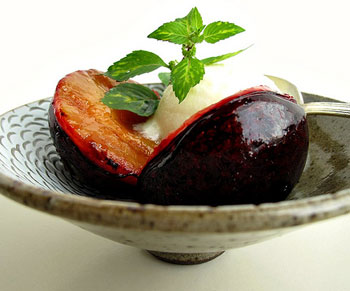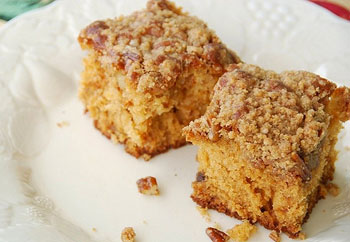 Pork and apples go hand in hand, don't they? That image of a whole spit-roasted pig comes to mind with the apple stuck in its mouth. There is something special about the sweet taste of apples and the full flavor of pork that work so well together in a dish. Roasting the pork and apples together is the perfect way to marry the two flavors. That's exactly what I do in this pork roast recipe, which is flavored with honey, mustard, and rosemary. For this perfect flavor pairing, I roast tiny lady apples alongside the pork.
Pork and apples go hand in hand, don't they? That image of a whole spit-roasted pig comes to mind with the apple stuck in its mouth. There is something special about the sweet taste of apples and the full flavor of pork that work so well together in a dish. Roasting the pork and apples together is the perfect way to marry the two flavors. That's exactly what I do in this pork roast recipe, which is flavored with honey, mustard, and rosemary. For this perfect flavor pairing, I roast tiny lady apples alongside the pork.
For a roast like this, pork tenderloin is the easiest to prepare and the most flavorful and moist. It's lean, roasts fast, and it stays tender, just as the name would suggest. The juices that collect in the pan go into the making of a gravy that has the flavor of the honey-Dijon rub, the rosemary, and the sweet apple juices. The rosemary sprigs that roast alongside the loins become crispy and are entirely edible, lending bursts of woddsy flavor to each bite. A meal such as this would be great for an elegant holiday dinner or even a simple Sunday supper.
Fall
Fall
Brown Sugar-Glazed Grilled Plums
 Plump, sweet, and juicy—these are the best-tasting plums. Late summer brings with it all the different types of plums—colors of white, black, red and shapes of round and oval. There are too many varieties to list here. And don't forget pluots, a cross between plums and apricots. I love to eat them fresh—and you know they're good when the juices run down your arm. But as you've seen by reading here, I also adore plums in simple, homey desserts.
Plump, sweet, and juicy—these are the best-tasting plums. Late summer brings with it all the different types of plums—colors of white, black, red and shapes of round and oval. There are too many varieties to list here. And don't forget pluots, a cross between plums and apricots. I love to eat them fresh—and you know they're good when the juices run down your arm. But as you've seen by reading here, I also adore plums in simple, homey desserts.
Instead of the typical preparation, these plums are grilled. Grilling fruit is not a typical technique, but it's great for bringing out the flavor of fruit, especially when it's a bit underripe. Imagine pineapple slices, peaches, or nectarines on the grill. These fruits nicely caramelize, especially when they're brushed with a sugar mixture. And what goes better with warm fruit than ice cream? This is a dessert to savor spoonful by spoonful.
With just three ingredients, this recipe is almost a nonrecipe. Brush the plum halves with a mixture of sugar and butter that caramelizes on the grill. Serve with ice cream, like my lavender-crème fraîche ice cream, which lends a unique flavor to the dessert. Take the opportunity to grill some fruit before summer ends!
A Taste of Fall
 There's nothing more spectacular than the brilliant colors of Autumn in the South, especially the trees that turn deep shades of amber and ruby red. It's my favorite time of year to visit the farm in middle Georgia, where I grew up and all of my family still resides. The 2 hour drive from my home in Atlanta takes me to a place that is truly another world. A phone call from my niece, Caroline, asking me to take her and her best friend to the Georgia National Fair, in nearby Perry was a good enough reason to go home for a long weekend.
There's nothing more spectacular than the brilliant colors of Autumn in the South, especially the trees that turn deep shades of amber and ruby red. It's my favorite time of year to visit the farm in middle Georgia, where I grew up and all of my family still resides. The 2 hour drive from my home in Atlanta takes me to a place that is truly another world. A phone call from my niece, Caroline, asking me to take her and her best friend to the Georgia National Fair, in nearby Perry was a good enough reason to go home for a long weekend.
As I start to mourn the loss of peaches and summer tomatoes (the one's that are actually red inside and taste like tomatoes), the cool weather ushers in the fall crops. My Dad planted, many years ago for his grandchildren, an entire orchard devoted to autumn crops. There are many different varieties of pears, figs, and pomegranate trees all of which are surrounded by an orchard of pecan trees. I think my dad had some sort of fairy tale vision of picking up his grandchildren at the bus stop after school and taking them to the orchard where he could sit in his swing and watch them frolic among the trees while eating fresh picked pears and figs.
Pear and Cardamom Coffee Cake
 It's the same every autumn. Pears sit quietly in the wings while apples take center stage.
It's the same every autumn. Pears sit quietly in the wings while apples take center stage.
It's no wonder. Think about it. Do kids crave candied pears every Halloween? Do moms pack pear sauce in their kids' lunch boxes? Can something be as "all-American as pear pie"?
Pears are good. Some pears, such as Seckel pears – diminutive, super sweet fruits – are surprisingly good. Overall though, they just don't get the respect of apples.
When it comes to baking, however, pears blossom into something special. In fact, I have made this cardamom coffee cake with pecan streusel twice – once with apples and once with pears. You can tell which one I preferred.
Given their mild flavor, pears work beautifully with cardamom, a enticingly fragrant spice. Though a relative of ginger, cardamom has a unique flavor that is difficult to describe. It is intensely aromatic yet not overwhelming in flavor. It has notes of ginger, clove, and citrus, which is why it works so well when paired with fall fruits.
So, go ahead and give pears a little limelight.
Kohlrabi Soup
 Kohlrabi, a vegetable that sounds just as foreign as it is alien to most people, is a subtle-flavored vegetable in the cabbage family. In fact it's German name translates to cabbage (kohl) turnip (rabi). Varieties include purple and pale green. It often gets confused with rutabagas or turnips, but it's actually much more attractive than both. Kohlrabi can be eaten raw (its taste resembles that of radishes) or cooked (where its taste is similar to boiled broccoli stems). This creamy soup is the perfect recipe for kohlrabi, because the vegetable turns sweet and tender.
Kohlrabi, a vegetable that sounds just as foreign as it is alien to most people, is a subtle-flavored vegetable in the cabbage family. In fact it's German name translates to cabbage (kohl) turnip (rabi). Varieties include purple and pale green. It often gets confused with rutabagas or turnips, but it's actually much more attractive than both. Kohlrabi can be eaten raw (its taste resembles that of radishes) or cooked (where its taste is similar to boiled broccoli stems). This creamy soup is the perfect recipe for kohlrabi, because the vegetable turns sweet and tender.
This recipe is based on my mother's version. Her soup is a Hungarian specialty. It's wonderful for a first course before an elegant dinner. When you match it with a big chunk of bread or crackers, it's even great as an entire meal. Its creaminess and sweetness always hits my comfort spot. And even though, as a kid, I never thought of kohlrabi as much of a vegetable, I still always asked my mom to make this soup in the fall and winter.
More Articles ...
Welcome to the new One for the Table ...
Our Home Page will be different each time you arrive.
We're sure you'll find something to pique your interest...


